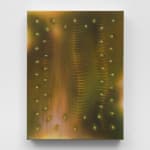Natacha Donzé
Metabolism, the spell, 2025
Acrylic on canvas
30 x 40 cm
11 3/4 x 15 3/4 inches
11 3/4 x 15 3/4 inches
Copyright The Artist
Photo: Marjorie Brunet Plaza
Further images
In der Werkserie „Metabolism“ (2025) treten skelettartige Schlangenformen aus dunklem Grund hervor, deren Wirbelsäulen in leuchtenden Linien nachgezogen sind. Auf bloße Knochen reduziert, erscheinen sie zugleich als Fossilien, Diagramme und...
In der Werkserie „Metabolism“ (2025) treten skelettartige Schlangenformen aus dunklem Grund hervor, deren Wirbelsäulen in leuchtenden Linien nachgezogen sind. Auf bloße Knochen reduziert, erscheinen sie zugleich als Fossilien, Diagramme und Schaltpläne. Stoffwechsel wird in diesen Werken zum Prinzip der Verwandlung: was verzehrt wird, kehrt in neuer Gestalt zurück; was zerfällt, bildet die Basis für Erneuerung. Das schwache Leuchten der Schlangen gegen den dunklen Hintergrund trägt eine stille, fast sakrale Resonanz – sie wirken wie Relikte digitaler Schemata. In diesem Sinn stehen die Tiere weniger für Bedrohung als für Beharrlichkeit: Verkörperungen eines Zyklus, der Körper und Technologien, organische Substanz und digitale Prozesse verbindet.
In the series “Metabolism” (2025), skeletal snake forms emerge from a dark ground, their spines traced in luminous lines. Reduced to bones without flesh, they appear at once as fossils, diagrams, and fragments of circuitry. The works explore metabolism as a principle of transformation: what is consumed returns in another form, what decays becomes the basis for renewal. The pale glow of the snakes against the dark surface carries a quiet, almost sacred resonance – suggesting relics as much as digital schemata. In this sense, the snakes are less symbols of threat than of persistence, embodying a cycle that connects bodies and technologies, organic matter and digital processing.
In the series “Metabolism” (2025), skeletal snake forms emerge from a dark ground, their spines traced in luminous lines. Reduced to bones without flesh, they appear at once as fossils, diagrams, and fragments of circuitry. The works explore metabolism as a principle of transformation: what is consumed returns in another form, what decays becomes the basis for renewal. The pale glow of the snakes against the dark surface carries a quiet, almost sacred resonance – suggesting relics as much as digital schemata. In this sense, the snakes are less symbols of threat than of persistence, embodying a cycle that connects bodies and technologies, organic matter and digital processing.









